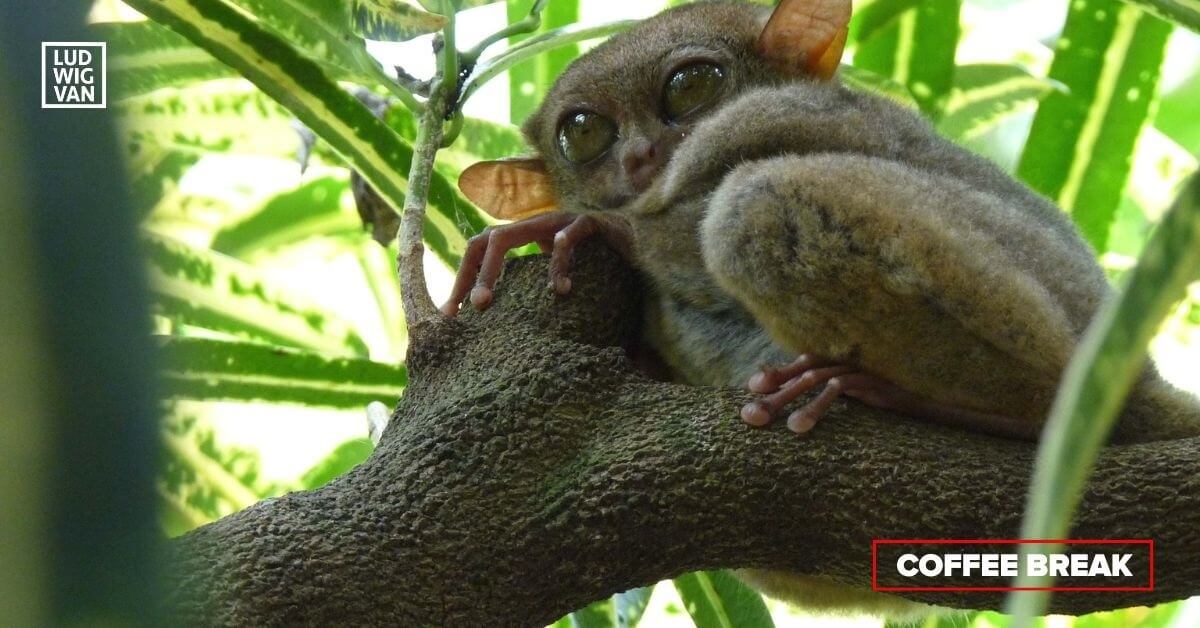
Operatic virtuosity is linked to mating success among small tree-dwelling primates known as tarsiers. A new study by researchers at Sam Ratulangi University in Indonesia and Cornell University in the US, recently published in the journal Frontiers in Ecology and Evolution, documents and studies early morning tarsier duets.
Is it only music when humans create? The results of the study are intriguing, and underscore the expressive power of sound.
The Tarsier
Tarsiers are small primates who live in the Philippines, Indonesia, and Malaysia. They are nocturnal, and with their large eyes and ears, are speculated to have been the inspiration for Yoda, the Star Wars character. Gursky’s spectral tarsiers live only on the island of Sulawesi in Indonesia, and are distinguished by specific genetic features, along with their distinctive vocalizations, and fur.
Quick facts:
- They weigh about 7 ounces or 200 grams, and measure 9 to 15 centimetres (3.5-6 inches) tall.;
- They are monogamous;
- Each pair occupies a territory ranging between about 1.5 and 4 hectares;
- They defend their territory by singing what researchers call duets;
- Young tarsiers sometimes join in their parents’ songs.
There are some differences between human and tarsier duets. Tarsiers vocalize in a range of frequencies, rather than in discrete notes like we do.
In tarsier terms, what the researchers dubbed coloratura amounts to repeated notes that are sung as a coordinated duet between male and female tarsiers. The tarsiers seem to be competing in a sense, singing higher and with more rapid repetitions.
Just like human beings, the tarsiers don’t all exhibit the same talent for vocalism. Some are better at speed, while others can sing higher — and it’s rare for an individual to display talent in both areas. The researchers postulate that the complex patterns of the duets are a form of communication to other tarsiers.
“Here we show that Gursky’s spectral tarsier duets exhibit acoustic trade-offs in note rate and note bandwidth — that is, the range of frequencies within a note,” said first author Isabel Comella, a researcher at the K Lisa Yang Center for Conservation Bioacoustics and a recent Cornell University graduate, quoted in Phys.org.
The Study
Autonomous devices, along with handheld digital recorders, were used to capture the early morning cries of Gursky’s spectral tarsiers (Tarsius spectrumgurskyae) in Tangkoko National Park in Sulawesi, Indonesia. The park’s tarsiers aren’t afraid of humans, which made installing the recording devices in their jungle habitat easy. The researchers recorded 50 such vocalization duets, incorporating 6,681 notes, all sung by male/female pairs.
- The notes were analyzed based on frequency range, bandwidth, duration, and speed;
- The duets lasted between 13 and 204 seconds;
- Both male and female tarsiers would begin the songs.
The paper’s authors suggest that the vocal displays are a measure of the physical fitness and mating ability of the individuals. Those who sang in a limited range, or more slowly, were much less likely to be part of a tarsier duet.
The results are interesting, and open the door to many other questions. The researchers noted that female tarsiers, in particular, seemed to suffer the most from poor vocalization ability. But, why should it be so difficult for females in particular?
“There is still so much to be learned about the function of tarsier duets: the information they contain about the calling animals, and what information other tarsiers pick up on. The possibility that duets contain information about the fitness of a calling individual — the vocal equivalent of a peacock’s tail — is an exciting avenue for future research. In our study we showed that this trade-off exists, and now it is up to others to help us understand what it means,” senior study author Dena Clink, a researcher at Cornell’s K. Lisa Yang Center for Conservation Bioacoustics, told Phys.org.
Some lemurs, titi monkeys and northern gray gibbons also sing duets, as it turns out. Other studies suggest that social bonding may also be a benefit of the primates’ behaviour. It may be a way to reunite the whole group after a night of foraging for insects.
The researchers plan on more study of the tarsiers and their duets, which include both the range of human hearing and beyond to the ultrasonic.
Can what tarsiers do be properly called opera? Certainly, it serves as a kind of shared musical expression in their world, and echoes the very deep connections between music and our own species.
#LUDWIGVAN
Get the daily arts news straight to your inbox.
Sign up for the Ludwig van Daily — classical music and opera in five minutes or less HERE.
- INTERVIEW | Larry Weinstein Talks About His Film Beethoven’s Nine: Ode To Humanity, Premiering At Hot Docs - April 18, 2024
- PREVIEW | JUNIOR Festival Offers A May Long Weekend Of Arts & Performances For Kids - April 18, 2024
- PREVIEW | Esprit Orchestra Ends 2023-24 Season With Sonic Universe - April 17, 2024



